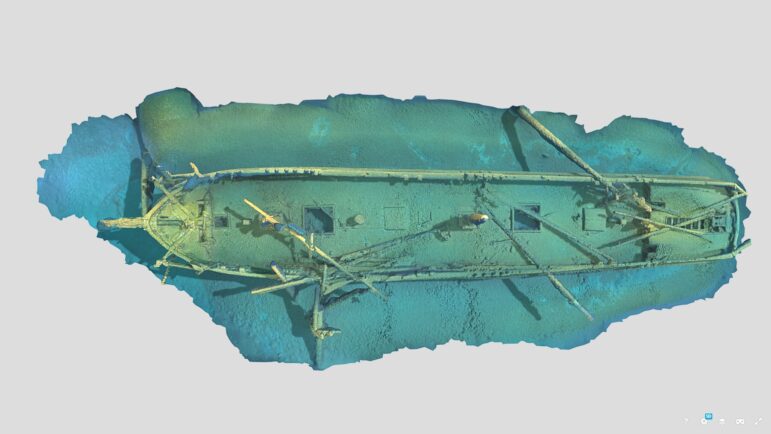
Wisconsin Historical Society
Pieces of wreckage of the Mojave are visible on the bottom of Lake Michigan.By ERIC FREEDMAN
Capital News Service
LANSING – A Detroit-built sailing ship that sank in Lake Michigan during an 1864 storm has been added to the National Register of Historic Places.
The three-masted Mojave, only 1 year old at the time, went down in heavy weather while northbound on route from Chicago to Buffalo with a load of grain.
A newspaper reported at the time: “The master of the bark Monarch reported seeing the Mojave drop into the troughs of the heavy seas that were running at the time, become swamped and disappear.”
The doomed ship was never seen again.
At least five crew members died, including 30-year-old Capt. Darius Nelson Malott, and “their remains were not recovered,” according to the Wisconsin Historical Society. The inscription on Malott’s memorial marker in Lakeview Cemetery in Leamington, Ontario, reads, “Lost with the Barque Mojave on Lake Michigan.”
In 2016, shipwreck hunter Steve Radovan discovered the well-preserved Mojave 12½ miles northeast of the Sheboygan, Wisconsin, Breakwater Lighthouse. The ship is partially embedded in the lakebed 295 feet below the surface, the society said.
“The vessel is completely intact up to the main deck, and two of its three masts remain standing,” it said.
The National Register is part of the National Park Service and is the “nation’s official list of historic places worthy of preservation. It includes buildings, sites, districts and structures, as well as shipwrecks.
The Mojave was built by Stuart McDonald and launched in November 1863 in Detroit, its home port.
“The Mojave was outfitted with elaborate cabin accommodations making the vessel one of the most elegant ships afloat,” according to wisconsinshipwrecks.org.
Elegance wouldn’t save it from disaster, however.
In fact, the Mojave appeared to be an ill-fated ship from the beginning of its short life.
First, inclement weather delayed its launch ceremony by almost a week.
Then in April 1864, it ran aground on Middle Island in Lake Erie and had to be towed to Detroit for repairs, according to wisconsinshipwrecks.org.
And then in July 1864, it ran aground in thick fog on Skillagalee Reef carrying 20,000 bushels of wheat. The reef is between Beaver Island and the Michigan mainland northwest of Cross Village.
“The crew threw a quantity of the cargo overboard to lighten the ship to get it off the reef, wisconsingshipwrecks.org said.
The historical society describes the Mojave as a square, boxy barkentine “designed to navigate the locks of the Welland Canal in Ontario, which allowed ships to avoid Niagara Falls.”
“Canallers sailed from ports on western Lake Michigan, delivering grain to ports on Lakes Erie and Ontario. On their return to Lake Michigan, vessels like the Mojave were often loaded with coal, used for heating Midwestern cities and powering factories,” the society said.
The society cautions that federal and state laws protect the wreck and prohibit divers from removing artifacts and structures. There are criminal penalties for removing, defacing, displacing or destroying artifacts.

Zach Whitrock, wisconsinshipwrecks.org
Overhead view of a photogrammetry model of the Mojave.